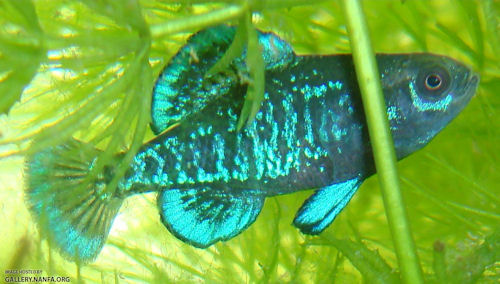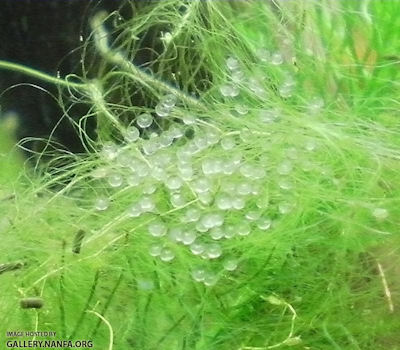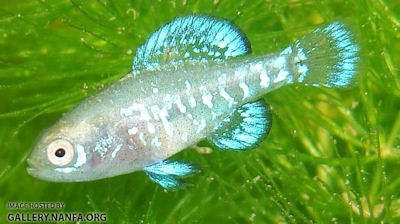Fish in Focus: Gulf Coast Pygmy Sunfish, Elassoma gilberti

Elassoma gilberti
Photo by Erica Wieser
Elassoma gilberti, the Gulf Coast Pygmy Sunfish
(Originally published in American Currents Fall 2012 by Erica Wieser)
Elassoma gilberti, the Gulf Coast Pygmy Sunfish, was distinguished in 2009 by Snelson, Krabbenhoft, and Quattro as a separate species from its close relative, Elassoma okefenokee. The two species are very similar but differ in the number of preopercular canal pores (four for gilberti and three for okefenokee) and number of anal fin rays (seven in gilberti and eight in okefenokee). In general, the western side of Florida near the Gulf of Mexico contains gilberti and the eastern coast near the Atlantic Ocean has okefenokee. The type locality for gilberti is near Tallahassee, Florida.
I acquired my first Elassoma gilberti from a fellow NANFA member in the fall of 2010. At the time I didn’t have very much experience in native fish, egg layers, or live food cultures. I set the Gulf Coast Pygmy Sunfish up in a 10-gallon aquarium with live plants, sand, some terra cotta pots, snails, and an air stone. I didn’t use a heater or a filter. I bought them some live blackworms from a local pet store and was pleased to see the fish eat them.
I was delighted when the male did his first courtship dance. These fish change color based on their mood. When they’re stressed out, submissive, trying to be ignored, or not feeling well, they’re clear. When they feel happy, boisterous, dominant, and are courting a female, the males turn dark black which makes their shiny blue stripes really stand out. Dominant males perform a complex wiggly-waggly dance with their fins that you really have to see to believe. They hold their bodies perfectly still and jiggle their fins around unlike anything else I’ve ever seen. These fish are so much fun to watch, I moved them into their very own 55-gallon aquarium with pure clay kitty litter substrate, live plants, and a hang-on the back waterfall filter. In the larger space, even more males colored up and began courting females.
If the male successfully woos a female into his clump of plants and they spawn, he chases her and other fish away for a few days until the eggs hatch. Then once they have hatched, he resumes courting females. If they are kept well fed, Elassoma gilberti males spend the majority of their time dancing and courting. Fry are almost a side effect of keeping the fish well fed and happy. They don’t seem to be picky about water hardness at all; my fish have spawned in both 17 and 0 degrees of hardness. The picture below is of a clutch of Elassoma gilberti eggs that have been caught in the cladophora algae growing around Myriophyllum pinnatum. Normally, eggs fall through the plants and lay on the ground. This was a rare instance of the fry staying suspended up in the tank where I could get a photo of them.
 |  |
The fry are very opportunistic and will hang out in the part of the tank where the most food is. In a tank with few surface plants and frequent feedings of microworms (which quickly sink to the bottom), they spent their time hunting microworms in the cover of the plants at the bottom of the tank. In a tank with lots of rotifers and duckweed, the fry spent their time near the surface in the duckweed roots hunting the microfauna. Elassoma gilberti, even as fry, are ambush predators that like to spend their time motionless hiding under cover, pouncing on, and eating live foods.
Elassoma gilberti adults will eat a variety of foods, but some work better than others. I used to buy Californian blackworms from a local pet store and dump them into the tank with the pygmy sunfish. Blackworms are an excellent food for getting the fish in spawning condition, as the Elassoma hungrily eat the worms and become nice and fat. Blackworms are to the fish tank what earth worms are in the garden; they breathe water and live in the substrate, eating detritus and will even reproduce. If you have pygmy sunfish and want to go on vacation for a few weeks or a month, add a few bags of Californian blackworms to your tank and the fish will be well fed while you are gone. But the downside to blackworms is that the fish do not get socialized. When they’re hungry they hunt for their food. Your human face in front of the tank is never associated in their minds with feeding time, so the fish are never trained not to fear you. Also, blackworm cultures are often infested with a blackworm-eating leech that will over time eat your entire blackworm population. That is what happened in my tank; one day the blackworms were gone and instead there were a lot of tiny leeches and one horrifying six-inch long leech. I did a complete tank re set up (I was moving anyway so I just left the old substrate behind and bought new substrate when I arrived) and thankfully the creepy leeches got left behind, too. I use pure clay kitty litter in my aquarium, so tossing all the old stuff and buying all new only costs $4 for 25 pounds. That is the advantage of using pure clay kitty litter or a soil substrate capped with gravel when compared with the expensive brands designed for planted aquariums; if you need to throw it all out and buy more you can do so without spending $70 on replacement substrate for your 55-gallon tank.
Flake food is the Gulf Coast Pygmy Sunfish’s least favorite food. When I fed my colony flake food, a certain percentage learned to eat it, another percentage ate only enough to survive, and another percentage of the fish refused to eat flake food at all and starved to death. But the real problem with flake food is that when I switched from blackworms to crushed flake food, all fry production stopped. Elassoma gilberti are a very short-lived species, living only one or two years. Keeping them is more about keeping a breeding colony than it is about keeping any one individual fish. If they stop producing fry, then very quickly you will not have any more pygmy sunfish in your pygmy sunfish tank. I was also worried that if I let the gap between fry production stretch too long, when I tried to breed them again the population might be too old and might not be able to produce viable offspring. This turned out not to be a problem, as when I switched from flake foods to grindal worms, the fish started breeding as soon as they’d fattened up again.
There are two foods that through trial and error have become my favorite things to feed to adult Elassoma: frozen bloodworms and cultured grindal worms. Frozen bloodworms are expensive ($5 to $10 a month), but readily available at most pet stores. My local pet store sells them for $5 for 30 cubes. To feed the Elassoma, I would get a cube, hold it with my 10-inch planting tweezers ($5 on ebay), and with my other hand, use scissors to cut bloodworms off of the cube. Bloodworms are a little bit too large to fit in the mouth of an Elassoma gilberti, so it helps to cut them into pieces. The advantage to this food over blackworms is that the Elassoma are forced to recognize the human activity near their aquarium as being related to getting fed. Correlating humans with food tames the fish and makes them more likely to come out of the plants when you are present. Elassoma that have not been tamed remain invisible within the plants and are much less entertaining than tamed fish. I would feed the Elassoma twice a day (two cubes a day) which works out to about $10 a month in fish food. To me, that is unacceptably expensive, so I now exclusively feed them grindal worms.
Grindal worms are in my opinion the absolute best food to feed to Elassoma gilberti. They are inexpensive, readily eaten, don’t take up much space to culture, and require very little maintenance. I culture mine in plastic shoe boxes on dollar store sponges and feed them kibbles of dog food. The diagram below shows the side view of the culture. The worms breathe in humid air but drown in full water, so I fill the box up halfway with water and the worms live and crawl around in the sponges that are above the water line. Not pictured is a lid with air holes drilled in it.
About once a week or once every two weeks I take the box to the sink, open the lid, set the top sponges with the worms in them on the lid, rinse out the bottom sponges and the plastic box, put the sponges back in, add fresh water, and put the culture back. The whole process takes about five minutes to clean all of my plastic shoe box cultures, which I then return to their drawer under the aquarium. It requires very little space and very little time.
One tip I would give is that if a piece of kibble lying on the worm sponges grows fungus, take it out because the worms won’t touch it. Fungus is a sign that you are over feeding the worms. Add only as many kibbles as they’ll eat in a few days.
 | 
|
There are some common misconceptions about pygmy sunfish that I have found to not be true. For example, some people say that Elassoma need a tank with absolutely no current. I have video posted on my youtube account (name of Okiimiru) of Elassoma gilberti, not only in a tank with current, but right up where the current is strongest, playing in it. Like most misconceptions this one has a hint of truth to it: Elassoma are one-inch long fish. The current that a big sunfish or darter might rate minimal would to a one-inch fish seem torrential. But as long as you give them regions of the tank without current to rest in, they will willingly venture into the thick of things to play when they are bored. Yes, there does need to be a region of the tank with zero current for them to rest. And it would be helpful if the filter or powerhead had a sponge over the intake to prevent the tiny fry from getting sucked in. But are these obligate slackwater fish? No. They are just tiny and they need to rest. If you set up one corner of the tank with current, they will go play in it.
Another misconception is that these fish do best in tiny planted tanks. These fish are ambush predators. As long as you give them food to hunt (grindal worms) and a shadowy place to hunt them from, they don’t care if those shadows are cast by live plants, fake plants, a statue with a treasure chest and a ‘No Fishing’ sign on it, whatever. They are really not very picky. They are, however, extremely territorial. If you don’t block the sight lines with some sort of barrier, you’ll only have one colorful male at a time. The moment another male colors up and begins to court a female within the sight line of the dominant male, he’ll rush in and chase off the new male, forcing him back into submissive coloration. You can have more colorful males at one time if you break up the sight lines with some sort of tank decoration. Plants work, but so would anything else that is aquarium safe.

Another misconception is that these fish are delicate and have a preferred pH, hardness, or temperature range. As I mentioned before, I have spawned this fish in both pH 6.5, 0 DH water and pH 7.5, 17 DH water. They are really not picky and if drip acclimated will adjust very well to whatever your water is. I have both kept a heater in their tank and have gone without and they don’t seem to care one way or another. There is continuous dancing and fry production as long as you keep them well fed (I use grindal worms). Really, this is quite an easy fish to keep and breed. The key to keeping them is getting them to eat. Once you’ve done that, they’re very hardy. Mine have never gotten ich, velvet, mycobacterium marinum, flexibacter, columnaris, popeye, or any of the other diseases that my other species of fish have had. But when their year or two of lifespan is over, they do die. You’ll find them on the bottom of the tank, perfectly healthy looking apart from being dead. That’s why you’ve got to keep a colony of them. If fry aren’t being born or aren’t surviving to adulthood, very soon you won’t have any more fish. Just keep them well fed, keep them happy and spawning, and Elassoma gilberti can be a very easy and entertaining fish to keep in your home aquarium.
Check out the videos I’ve posted online of Elassoma gilberti males doing their courtship dance. It’s a movement I’ve never seen another animal perform. There’s nothing in the world like an Elassoma dancing.